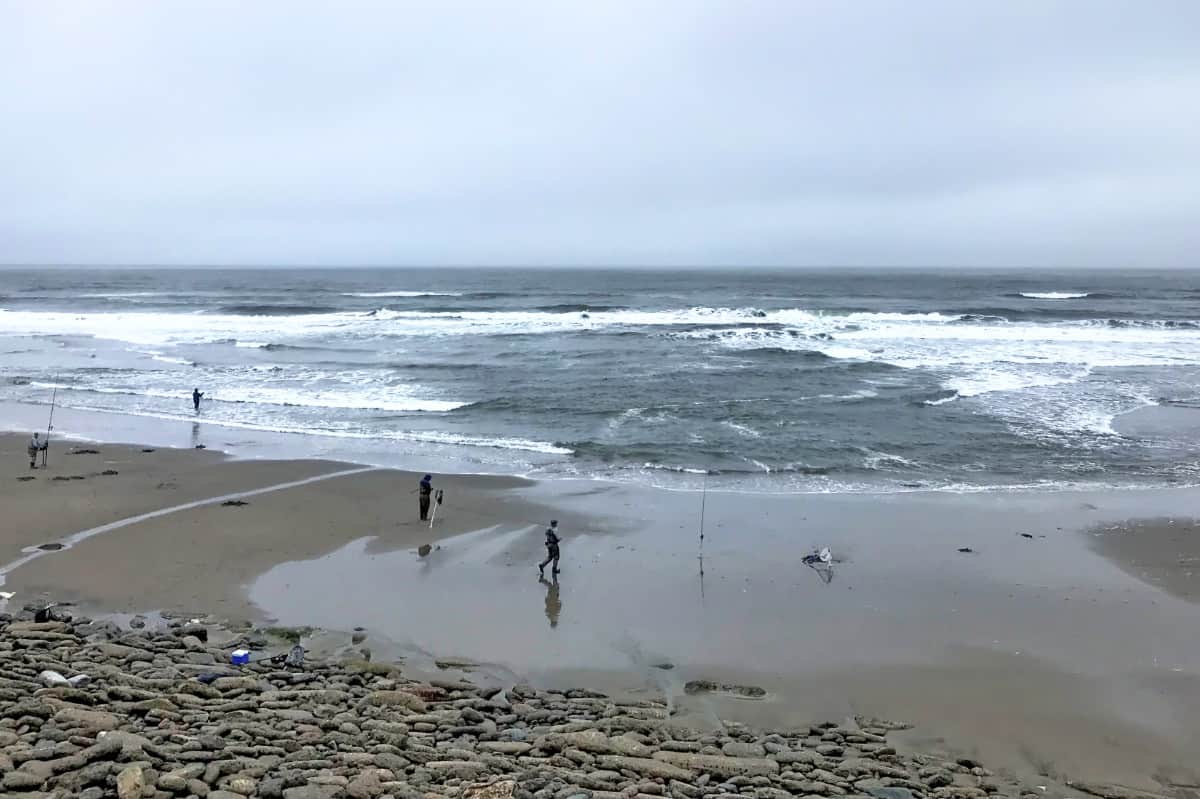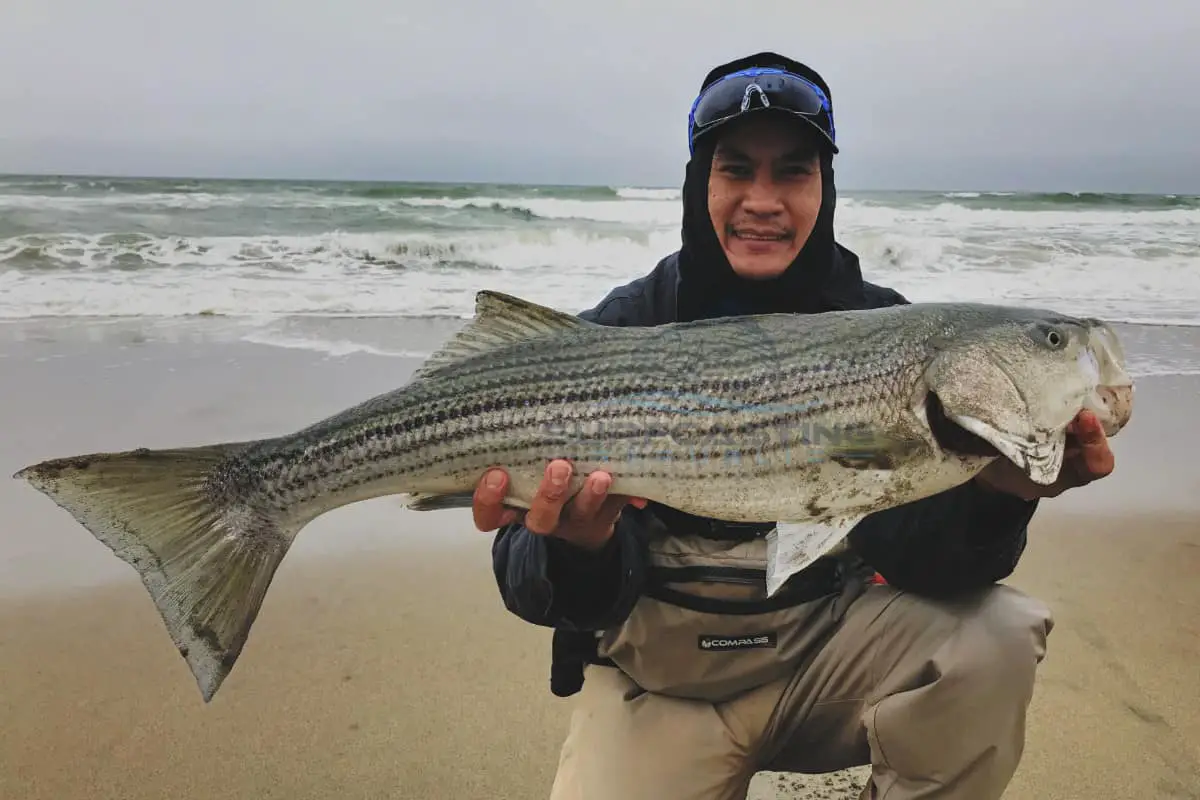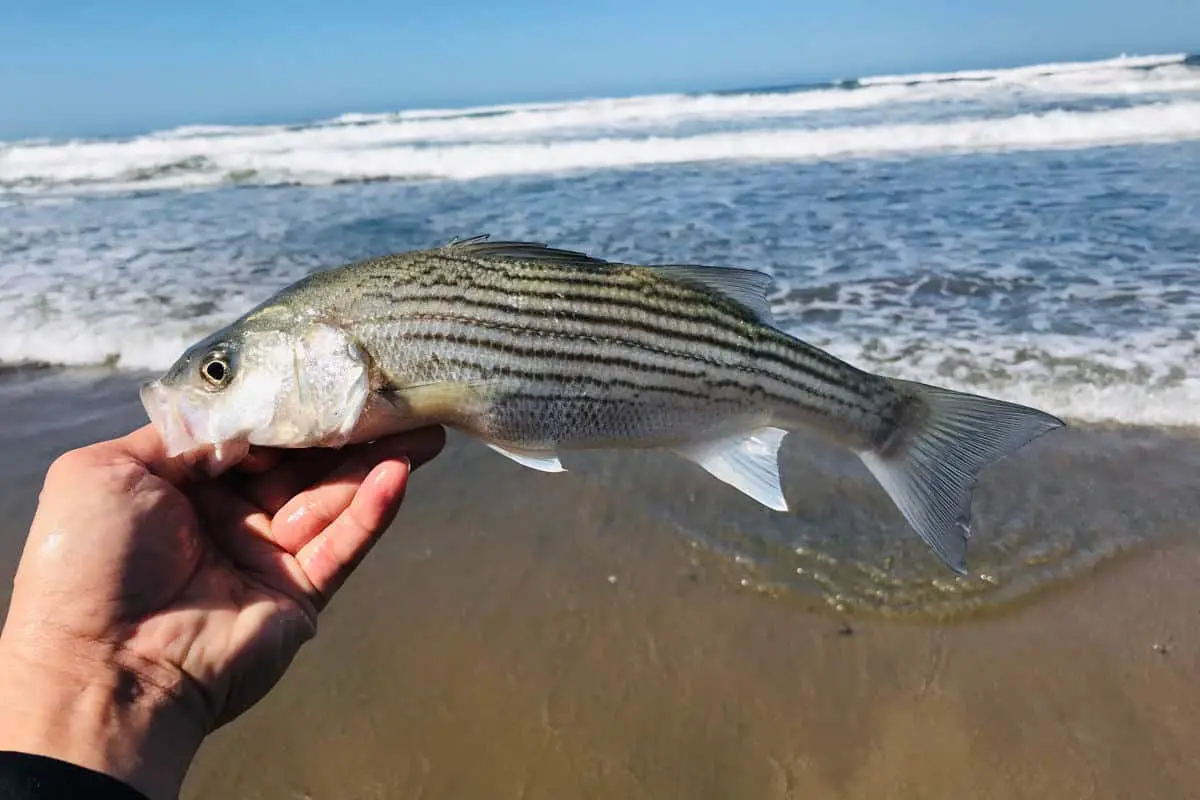I normally like to go fishing early in the morning, which is naturally the best time to catch most varieties of fish. However, the last few times I went out in the morning looking for stripers, I didn’t get a single bite.
It turns out there are many other factors that determine the best time to catch these elusive fish. Besides the time of the day, I should have considered the time of the year![]() , the weather, and the tide.
, the weather, and the tide.
When Is the Best Time, Weather, and Tide to Catch Striped Bass?
Striped bass is not the easiest fish to catch. While they are considered unpredictable, anglers may improve their chances of catching a striper by paying attention to the time of the day, the weather, and the tide. The typical recommendation is to fish about 2-3 hours before high tide to about 2-3 hours outgoing tide. Some anglers also recommend around dusk or dawn, on a cool day, during peak or slack tide.
Like many species of fish, stripers are most active with their feeding during dusk and dawn. Starting out just before sunrise or just before sunset may offer the best times of the day![]() to catch striped bass.
to catch striped bass.
This is when they are more likely to be nearer to the surface and more likely to bite. However, the current weather conditions and the tidal currents also affect how they feed and travel.
During peak tide, the currents are stronger, which stirs up sediment in the waters, especially near the shoreline. As baitfish feed on the sediment, stripers come to feed on the baitfish. This is also true just after stormy or windy weather.
During slack tide, when the currents are weakest, stripers tend to hunker down instead of searching for food. However, this also provides a prime chance to catch stripers using live bait while trolling deeper waters.
While fishing on a cool day after a storm or during peak tide may improve the chances of reeling in large striped bass, the season![]() and the location are also important considerations. The feeding habits of the striped bass may change based on the season and where they are located.
and the location are also important considerations. The feeding habits of the striped bass may change based on the season and where they are located.
The Best Season for Catching Striped Bass
Striped bass is migratory fish. The season ![]() and weather affect how they feed and travel. Stripers prefer cooler waters. Checking the current water temperatures may help anglers decide whether they should pack up and try again on another day.
and weather affect how they feed and travel. Stripers prefer cooler waters. Checking the current water temperatures may help anglers decide whether they should pack up and try again on another day.
Typically, stripers enjoy waters between 55 and 68 degrees Fahrenheit. If the water is cooler, they may travel to a warmer spot and spend more time near the surface. When the water is warm, stripers are often found in deeper waters.
During the warmer days of the summer, it is more common to see striped bass in dense schools. They are also less active near the surface, which can make it more of a challenge for surf fishing. Trolling provides the best way to catch stripers in the summer. You may need to go 30 to 60 feet deep to get a bite.
Topwater action is more common in the spring and fall, as the fish enjoy the cooler weather. In the spring, when the stripers are getting ready to spawn, anglers may struggle to get as many bites compared to other times of the year.
However, this also provides the best time to get a big catch when fishing freshwaters. The females may not reproduce, which results in more opportunities to land a big bite.
The winter can also be a great time to go fishing for striped bass. There are often fewer people fishing the lakes and rivers. However, stripers also tend to be more unpredictable during the winter.
They may be in a different location from day today. This is another season where trolling is the preferred fishing technique.
How to Find the Best Location for Striped Bass
As striped bass are migratory fish, they may not be found in the same location throughout the year. In the summer, you may need to reach up to 60 feet deep to get a bite. During the rest of the year, you may get bites from the surface or several feet below the water.
When surf fishing![]() or trolling the ocean, anglers have better luck away from the shore. The bigger fish are less likely to come near the shoreline at any time of the year. However, in the springtime, striped bass may be found in the water just a few feet deep.
or trolling the ocean, anglers have better luck away from the shore. The bigger fish are less likely to come near the shoreline at any time of the year. However, in the springtime, striped bass may be found in the water just a few feet deep.
When fishing a lake, it is best to look for growth on the lake bed that may provide hiding spots for the striped bass. Water plants, algae, and other growth may be visible from the surface and is often found in deeper water.
A sonar fish finder may also help locate striped bass. These devices can be mounted to a boat and they use sonar to detect schools of fish. Depending on the fish finder, the device may keep track of the locations that were scanned, helping to create a map of the lake or river and the possible locations of striped bass in the area.
Trolling is also a good way to search for striped bass. Dropping a line and slowly trolling the waters is often a useful technique when the bass are not active on the surface.
When choosing a location![]() , anglers should also consider the migration of the fish. During the early spring, the fish are looking for shallow waters where they can spawn. Striped bass move downstream to spawn, which means that are often found in rivers, lakes, and inlets.
, anglers should also consider the migration of the fish. During the early spring, the fish are looking for shallow waters where they can spawn. Striped bass move downstream to spawn, which means that are often found in rivers, lakes, and inlets.
As the weather begins to warm, they migrate back toward the ocean. By the summer, anglers may have trouble finding striped bass in lakes or rivers.
However, there are also areas where striped bass has become landlocked, which prevents them from going back out to the ocean. Instead of migrating to the ocean, they may look for deeper water in the lake.
Tips for Spotting a Break in the Current

Anglers may also try to find striped bass by searching for a break![]() in the current. Striped bass tends to find structures below the water, where they can hide from smaller fish and wait for their food to pass by. These areas are mostly found where there is a break in the current.
in the current. Striped bass tends to find structures below the water, where they can hide from smaller fish and wait for their food to pass by. These areas are mostly found where there is a break in the current.
A current break is an area where the current breaks from its trajectory. As the waves roll in or the water rushes along the river, there are spots where the water is disturbed in its path. These breaks indicate that there is a big rock, plant growth, or a drop off below the surface.
During the summertime, when the bass is less active, these current breaks provide the perfect spot to search for striped bass. Depending on the depth of the water in the area, anglers may need to cast their line 40 to 60 feet deep to reach the bass.
Understanding the Tides in Your Area
While peak and slack tides may provide the best times for catching striped bass,![]() many people do not understand how to detect the tide
many people do not understand how to detect the tide![]() . The tide is not the same as the current. Currents move the water back and forth, while the tides move the water up and down.
. The tide is not the same as the current. Currents move the water back and forth, while the tides move the water up and down.
The tides are large waves that travel through the ocean due to the position of the sun and the moon. The tides begin in the ocean and travel toward the shore. When the tide comes in, the water level is higher, which is called high tide. When the tide rolls out, the water levels are lower, which is called low tide.
Peak tide is when the high or low tide creates the strongest currents. When the waves are coming in the strongest, you are likely witnessing peak tide. Slack tide occurs when the tide is about to reverse directions.
Detecting when these tides occur is not always easy. Most areas experience two high tides and two low tides every 24 hours and 50 minutes, due to the length of the lunar day. The extra 50 minutes means that the high tides and low tides do not occur at the same time every day of the year.
The best way to detect the tides is to check the local forecast. Weather channels and websites often provide a tide table for the closest shore. Most of these predictions are offered by the Center for Operational Oceanographic Products and Services (CO-OPS).
The Top Fishing Techniques for Catching Stripers
Along with selecting the right time, weather, and tide for catching striped bass, there are specific techniques that can help land a good catch.
Stripers are good at picking up vibrations. In fact, they can detect movement in the water up to 100 feet away. When fishing, it is important to keep your lure moving to help entice the bass. They may not easily detect a stationary lure.
The selection of bait is also important. Many anglers have success with live baits. Mackerel, anchovies, and herring are all popular choices. However, eels are a common recommendation from seasoned anglers.
Fishing with a live eel may help land a bigger catch. When fishing with an eel, the typical recommendation is to go to deeper waters. Remember to look for breaks in the current where you may find structures that the bass use for hiding.
It is also important to remember that striped bass is not always easy to predict. If there are no striped bass in the area one day, they may be easy to find the following day. Instead of giving up after an unsuccessful day on the water, anglers should consider coming back and revisiting the same area the next day.
[Related] How To Surf Fish For Striped Bass? A Complete Beginners Guide.![]()
Besides these tips and techniques, local bait shops are also a great source of information for catching striped bass. By asking the experts at the bait shop, anglers may discover the best areas and time of the day to fish.
As the behavior of striped bass can vary from location to location, the experts may also have advice on selecting the right bait.
How Big Does a Striper Need to Be Before You Can Keep It?

If the catch is too small, it may need to be released. Each state sets their own regulations for catching stripers. These regulations often include a daily bag limit. This limit specifies the number of fish that you can take home and sets a minimum length.
In most states, the daily bag limit is one striped bass with a minimum length of 28 inches. The State of California, the minimum length is 18 inches![]() . As the bag limit can vary, anglers should always check their local fishing regulations
. As the bag limit can vary, anglers should always check their local fishing regulations![]() when obtaining a fishing permit.
when obtaining a fishing permit.
How Big Does Striped Bass Get?
The average length of a mature striped bass is 26 to 50 inches. However, they can reach lengths close to 70 inches. These fish can live up to 30 years and may continue to grow in length and weight after reaching maturity.
However, they do not typically reach the minimum length of 28 inches until they are six or seven years old and they may weigh between 10 and 11 pounds.
Do You Need a Fishing License to Catch Striped Bass?
In almost every state, you need a fishing license for any type of fishing, even if you plan to catch and release. However, there are exceptions. In California![]() , anglers do not need a fishing license when fishing from a pier.
, anglers do not need a fishing license when fishing from a pier.
As striped bass are mostly found along the Atlantic Ocean and the various rivers, inlets, and lakes that flow from it, there is a good chance that anglers will require a fishing license for striped bass.
Before fishing, it is important to check the local fishing regulations and acquire the necessary license or permit.
Conclusion
Fishing for any type of fish can be a challenge and Striped bass are notorious for their unpredictable nature. However, there are ways to increase the chances of coming home with a good catch.
The best times to catch striped bass are when tide going up and down, and just before dusk and dawn, as the sun starts to set and rise. The fall is also a good time to go fishing for striped bass, especially during peak or slack tide.

